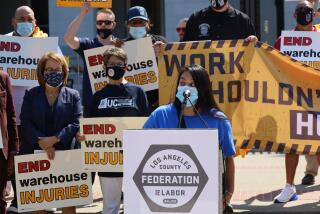Forum Reveals Divisiveness of Debate Over Ergonomics
- Share via
WASHINGTON — The Bush administration held its first hearing Monday to debate the need for ergonomics rules in the workplace, but the gathering was marked by charges from labor leaders that it was a “sham” and disrupted by protesters who were escorted out by police.
Labor leaders demanded that the government move to protect workers against repetitive-stress workplace injuries at the Department of Labor forum, which they charged had been stacked in favor of business interests.
But panelists representing business and industry countered with arguments that federal regulation would impose heavy costs on employers who already are taking steps against ergonomic injuries. Several doctors also testified that there is insufficient evidence linking physical factors on the job to conditions such as back pain and carpal tunnel syndrome.
Monday’s hearing in Arlington, Va.--the first of three being held across the country--showed the tough road ahead for the Bush administration as it considers how to address ergonomics, the study of adapting workplace conditions to workers. In March, Congress voted largely along party lines to kill ergonomics regulations passed by the Clinton administration less than two months after the rules took effect, a move President Bush supported. But the issue remains politically divisive among business, labor and health-care interests.
“We want to find a way to prevent ergonomics injuries that will survive the expected torrent of criticism, litigation and congressional review,” said Labor Secretary Elaine Chao in opening remarks.
Chao, who previously has said she will announce a final decision in September, warned that the failure of the Senate to confirm Labor Department nominees may delay the drafting of new ergonomics rules.
Labor Department statistics show that the musculoskeletal disorders which can arise from repeated, awkward or stressful motions forced nearly 600,000 employees to miss work in 1999.
The Occupational Safety and Health Administration claimed that the Clinton rules would cost employers $4.5 billion a year to implement and generate $9 billion in medical and workers’ compensation savings. But business interests insist that costs would have been much higher.
Chao asked all forum participants to focus on three issues: defining ergonomics injuries, determining whether they are work-related and developing ways that the government effectively can reduce them.
William Zollars, chief executive of Yellow Corp., stressed that, unless scientific evidence demands government intervention, businesses such as his trucking company should be permitted to develop their own workplace safety solutions. He said Yellow launched a $12-million safety initiative that cut lost-time injuries by 15% last year.
“We would have no problem with government regulation if it is scientifically supported,” Zollars said. “But if the science is missing, we will do more harm than good.”
Several doctors on the industry panel reinforced the doubts that Zollars cast on the scientific legitimacy of ergonomic injuries.
Swedish doctor Alf Nachemson said “complex individual and psycho-social work-related factors” such as depression, anxiety and stress were more responsible for back pain than physical characteristics on the job, and suggested that workers suffering from such conditions should not be given time off.
“It is better to stay at work with a little pain than to adopt a lifestyle of disability,” Nachemson said.
Occupational physician Dr. Jane Derebery expressed “serious doubt” that ergonomic injuries exist at all, saying that “scientific evidence does not support that carpal tunnel syndrome is caused by keyboards.”
AFL-CIO Secretary-Treasurer Richard Trumka led a rally before the forum denouncing the proceedings as unfairly tilted toward big business, leading Chao to remark, “It’s extremely disappointing to see some groups attacking these forums before they even begin.”
Still, shortly after Zollars’ testimony began, three protesters--one wearing a mask of President Bush--began shouting, “Big business loves the ergonomics sham.” They were removed by security.
During his testimony, Trumka maintained that ergonomics injuries already have been exhaustively studied and characterized, and that the government must issue a preventive standard “that requires employers to take action to reduce--and if possible eliminate--hazardous exposures, before workers are hurt or injured.”
Trumka cited National Academy of Sciences studies affirming the existence of workplace ergonomics injuries, but also sought to emphasize the potential savings that a strong OSHA regulation could produce for employers.
“We’re convinced that this can be a win-win scenario,” he said.
The Arlington forum concludes today, and additional forums will be held Friday in Chicago and on July 24 at Stanford University.
More to Read
Inside the business of entertainment
The Wide Shot brings you news, analysis and insights on everything from streaming wars to production — and what it all means for the future.
You may occasionally receive promotional content from the Los Angeles Times.










